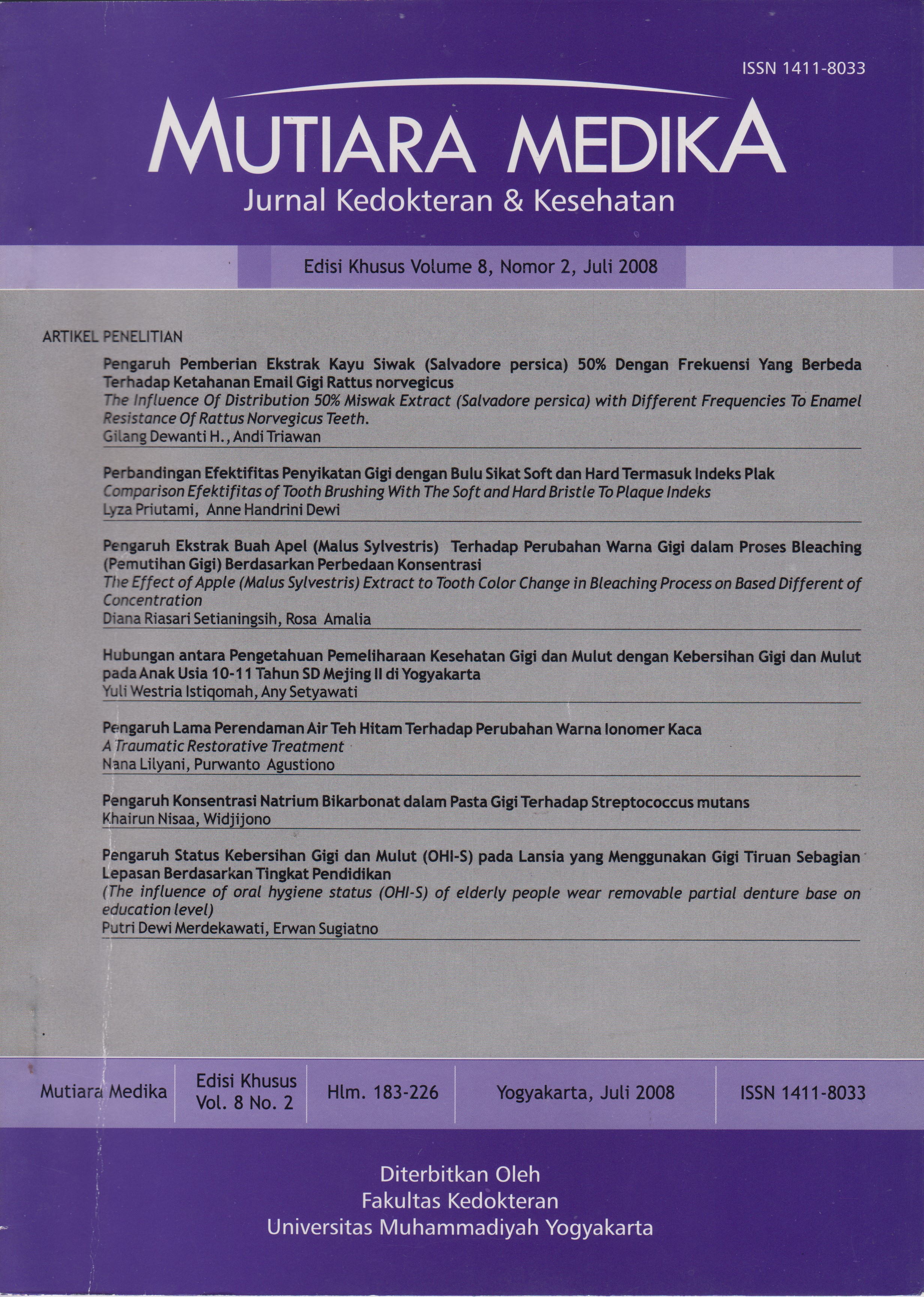Perbandingan Efektifitas Penyikatan Gigi dengan Bulu Sikat Soft dan Hard Termasuk Indeks Plak
DOI:
https://doi.org/10.18196/mmjkk.v8i2%20(s).9404Keywords:
Effectiveness, hard bristle, soft bristle, plaque removal.Abstract
The hardness of the toothbrush bristle is the important factor to be paid attention because it is directly felt when brush the teeth and related to the effect of tooth cleaning. The aim of this research is to get more information about effectiveness between soft and hard toothbrush bristle in clean up the plaques.
This research is experimental with 30subjects girl of University Muhammadiyah collage which is divided in to two groups (soft and hard group). Every group has 15 subjects and include on criteria which has been determined during I week. The researcher did examination of subjects plaques before and after brushing their teeth with toothbrush that gave by researcher: Subject asked to toothbrush 2 times a day with bass method in 2 minutes. The result was analyzed with independent t-test sample.
The result showed that there was significant difference between soft bristle and hard bristle in before and after brushing (p< 0, 05). On this result hard bristle shows more difference assess than soft bristle. In conclusion, hard bristle more effective than soft bristle in remove the plaque.
References
Allen, D. L. Fall W. T. Hunter G. C, 1980. Peridontic for the Dental Hygienis, 3th ed, Lea and Febiger. Philadelphia, h 172-173.
Amerogen, A. V. N., Michels, L. F. E., Roukema, P. A., Veerman, E. C. l., 1992, Ludah dan Kelenjar Ludah Arti Penting Bagi Kesehatan Gigi (terj), Gajah Mada University Pers, Yogyakarta, h 115.
Ariningmm, Ratih, 2000. Beberapa Cara Menjaga Kebersihan Gigi dan Mulut. Pusat Penelitian dan Pengembangan Pelayanan Kesehatan, Badan Penelitian dan Pengembangan Kesehatan Depanemen Keesehatan Rl. Jakarta, 45: 126: 2-3.
Carranza, F. A., Klokkevold, P. R and et al., 2006. Clinical Periodonlology. 10th ed. Sauders Elsevier. St.Louis. h 743
Chong. M. P., 1983, Characteristics of toothbrushes, J. Aus Dent, 28: 4: 202- 211.
Costa, C. C D, Costa Filho, L. C, Soria, M. L, Mainardi, A. P. R. 2001. Plaque Removal by Manual and Electric Toothbrushing Among Children, J of Odontopediatria, 15: 4: 296-301.
Dahlan, S. M. dr., 2006. Stalistika Untuk Kedokteran Dan Kesehatan. Arkansas, Jakarta, h 62-67.
Fedi, P. F. Vernin, O. A R dan Gray J. L, 2004. Silabus Periodonti, 4th ed. EGC, Jakarta, h 13, 74.
Harty, F. J dan Ogston, R, 1995, Kamus Kedokteran Gigi (ted). EGC, Jakarta, h 238.
Jo Forrest, 1993. Pencegahan Penyakit Mulut, 2nd ed. Penerbit Hypocrates, Jakarta, h 57.
Manson, J. D. dan Eley, B. M., 1993, Buku Ajar Periodonti. Edisi ll, Hypocrates, Jakarta, h 23-25, 95, 109-111.
Schimid, M. O dan Perry, D. A, 1990. Plaque Control in Carranza F. A and Odont. Glikmans Clinical Periodontologi, 7th ed. W. B Sounders Co, Philadelphia, h 684-686.
Sriyono, N. W., 2005. Pengantar llmu Kedokteran Gigi Pencegahan, Medika, Fakultas Kedokteran Gigi UGM, Yogyakarta, h 52-57.
Sriyono, N. W., 2007. Pengantar llmu Kedokteran Gigi Pencegahan, 2nd edition, Medika, Fakultas Kedokteran Gigi UGM, Yogyakarta, h 93-94.
Sriyono, N. W., 1997. Perbedaan Efektivitas Sikat Gigi Konvensional Bentuk Lama Dengan Bentuk Baru Dalam Pembersihan Plak Gigi, Ceramah lmiah Lustrum VIII FKG UGM. Bagian llmu Kesehatan Gigi Masyarakat dan llmu Kedokteran Gigi Pencegahan, UGM, h 122-126.
Stoltze, K and Bay, L, 1994. Comparasion of a Manual and a Electric Toothbrush for Controling Plaque and Gingivitis, J. C/in Periodontal, 21: 86-90.
Tan, H. H., 1993, Kesehatan Mulut dalam llmu kedokteran Gigi Pencegahan (ted), Gadjah Mada University Press, h 275-287.
Wilkins E. M dan Mc Cullough. P. A, 1964, Clinical Practices of The Dental Hygienist, 2nd ed, Lea and Febriger, Philadelphia, h 111, 126-287
Downloads
Published
Issue
Section
License
Copyright
Authors retain copyright and grant Mutiara Medika: Jurnal Kedokteran dan Kesehatan (MMJKK) the right of first publication with the work simultaneously licensed under an Attribution 4.0 International (CC BY 4.0) that allows others to remix, adapt and build upon the work with an acknowledgment of the work's authorship and of the initial publication in Mutiara Medika: Jurnal Kedokteran dan Kesehatan (MMJKK).
Authors are permitted to copy and redistribute the journal's published version of the work (e.g., post it to an institutional repository or publish it in a book), with an acknowledgment of its initial publication in Mutiara Medika: Jurnal Kedokteran dan Kesehatan (MMJKK).
License
Articles published in the Mutiara Medika: Jurnal Kedokteran dan Kesehatan (MMJKK) are licensed under an Attribution 4.0 International (CC BY 4.0) license. You are free to:
- Share — copy and redistribute the material in any medium or format.
- Adapt — remix, transform, and build upon the material for any purpose, even commercially.
This license is acceptable for Free Cultural Works. The licensor cannot revoke these freedoms as long as you follow the license terms. Under the following terms:
Attribution — You must give appropriate credit, provide a link to the license, and indicate if changes were made. You may do so in any reasonable manner, but not in any way that suggests the licensor endorses you or your use.
- No additional restrictions — You may not apply legal terms or technological measures that legally restrict others from doing anything the license permits.






